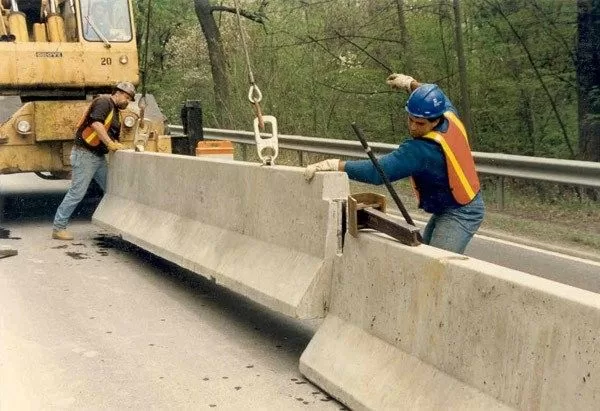Road safety is a paramount concern for transportation authorities and construction managers. Two popular types of concrete barriers often used to enhance safety are Jersey barriers and K-rails. While both serve similar purposes, Jersey barriers and K-rails have distinct characteristics that set them apart.
Jersey barriers, named after the New Jersey State Highway Department, feature a distinctive sloped design. K-rails, on the other hand, are known for their vertical sides and are commonly used in western states like California. These barriers for construction sites play crucial roles in traffic management, protecting workers, and preventing vehicle crossovers.
The choice between Jersey barriers and K-rails depends on specific project requirements, local regulations, and intended use. Understanding their differences helps planners make informed decisions to ensure optimal safety and efficiency in various traffic and construction scenarios.
Key Takeaways
- Jersey barriers have sloped sides, while K-rails feature vertical walls
- Both types serve as effective traffic control and safety measures
- Selection depends on project needs, local regulations, and intended use
Design and Physical Characteristics
Jersey barriers and K-rails have distinct designs that impact their performance and applications. Their shapes, dimensions, and materials contribute to their effectiveness in traffic control and safety.
Barrier Design Comparisons
Jersey barriers feature a distinctive profile with a broad base that narrows towards the top. The lower slope deflects vehicle tires, while the upper slope redirects the vehicle’s frame. K-rails, California’s version of Jersey barriers, have a similar shape but with slight variations in dimensions.
The Jersey barrier’s “break point” between slopes typically sits higher than the K-rail’s. This difference affects how vehicles interact with the barrier upon impact. F-shape barriers, an evolution of the Jersey design, have a lower break point that reduces vehicle lifting during collisions.
Constant-slope barriers offer another alternative, featuring a single, continuous slope from base to top. This design aims to minimize vehicle damage and improve safety outcomes in certain scenarios.
Materials and Variants
Concrete remains the primary material for both Jersey barriers and K-rails due to its durability and strength. These permanent installations provide robust protection in high-traffic areas and construction zones.
Plastic variants offer a lightweight, portable option for temporary traffic control. Plastic Jersey barriers and K-rails can be filled with water or sand for added stability. These barriers are easier to transport and reposition as needed.
Metal barriers strike a balance between strength and aesthetics, often used in urban settings where visual appeal is a consideration. Innovative shapes and materials continue to emerge, aiming to enhance safety and versatility in barrier design.
Applications and Safety Considerations
The two serve critical roles in traffic management and roadside safety. Their design features and placement significantly impact vehicle safety during collisions.
Usage in Traffic Control and Roadwork
Jersey barriers and K-rails are widely used as traffic barriers in construction zones and for temporary road closures. They effectively separate opposing lanes of traffic, protect work areas, and guide vehicles through detours. In roadwork scenarios, these concrete barriers shield workers from oncoming traffic and prevent vehicles from entering hazardous construction sites.
During major highway renovations, long stretches of Jersey barriers or K-rails create safe corridors for ongoing traffic flow. Their interlocking design allows for quick installation and removal, making them ideal for evolving construction needs. In urban settings, these barriers are often used to create dedicated bus lanes or pedestrian walkways, enhancing overall traffic flow and safety.
Impact on Vehicle Safety and Standards
The sloped design of Jersey barriers and K-rails plays a crucial role in vehicle safety during collisions. Upon impact, the angled lower portion helps redirect vehicles back onto the roadway, reducing the severity of crashes. This feature is particularly effective in preventing head-on collisions on divided highways.
Safety standards for these barriers are rigorously tested under NCHRP Report 350 guidelines. These tests evaluate factors such as:
- Vehicle stability post-impact
- Occupant risk during collisions
- Barrier deflection and debris scatter
Modern barriers are engineered to minimize vehicle damage and occupant injuries in low to moderate-speed impacts. Their height and shape are optimized to prevent most passenger vehicles from vaulting over the barrier, while still allowing for visibility across the roadway.
Conclusion
Jersey barriers and K-rails serve critical safety functions on roads and construction sites. While similar in appearance, they have distinct characteristics that suit different applications. Jersey barriers excel in permanent installations, offering superior impact resistance. K-rails provide versatility for temporary setups, with easier transportation and placement options. Understanding these differences allows for optimal barrier selection based on specific project needs and safety requirements.

